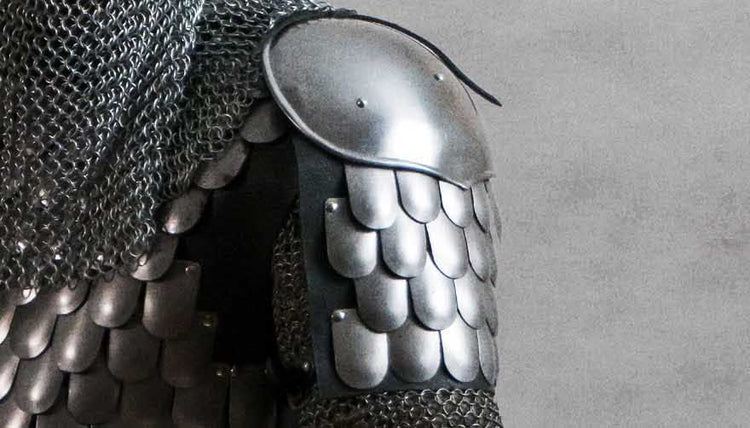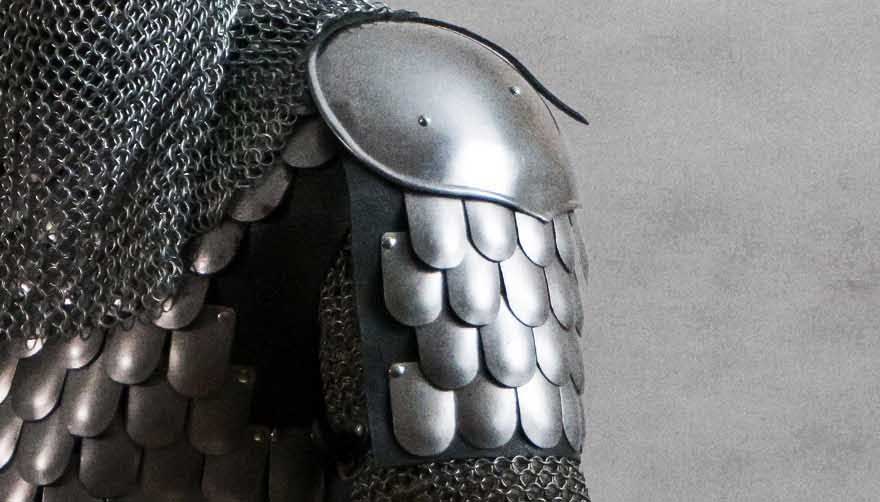Scales and Lamellas
Since prehistoric times, early human beings protected their bodies in battle against the effects of their opponents' weapons. Armour has pursued the same goal to this day. The parts of the body that are particularly vulnerable, and thus worthy of protection, have not changed over the millennia, but the technical means of protecting them have.
From time immemorial, the inventors and designers of armour have been faced with a fundamental problem: materials that are suitable for effectively warding off the effect of a weapon, a blunt blow, a cut, or a thrust, must be correspondingly resistant. Until modern times, this resistance has been associated with a lack of flexibility. Modern materials combine an impressive protective effect with minimal weight and maximum comfort. Depending on their structure, current protective vests made of materials such as Kevlar offer their wearer protection against blows, cuts, stabs, and even bullets. They are made of textile-like material that is versatile to work with, comparatively comfortable to wear, and only minimally restricts the wearer's freedom of movement. However, such materials and manufacturing methods have only been found since the 19th century. The knights of the Middle Ages and previous eras could only dream of this combination of properties.
The earliest armour consisted of materials that nature provided their inventors. Leather, tree bark, animal bones, wood, bamboo, everything that was regionally available and known for its durability was used within the limits of craftsmanship. As resistant as these materials may be, they are above all inflexible. Accordingly, it was hardly possible to make complete armour from tree bark or bone. It would have been nearly impossible for the wearer to take even one step, let alone fight in such an armour set. The only solution was to combine flexible materials with a low protective effect and less flexible ones with a high protective effect. For example, wooden staves or bones were attached to garments made of leather, and later to textile garments, to increase their resistance.
Advances in textile production and processing also lent a certain protective effect to visually simple clothing by manufacturing it from several layers and sewn-in padding. However, this was only very limited and usually served as a load-bearing base or supplement in conjunction with armour made of metal.
Small, Flexible, Secure
The increased use of metal plates for the production of armour parts significantly improved their protective effect. Depending on the respective level of development of the armoursmith's craft, such plate armour was characterized, at least initially, by enormous weight and often significantly restricted the wearer's freedom of movement. A complete set of plate armour was not only unimaginably expensive by the standards of the time, but it was also not very practical for combat use.
Both scale and lamellar armour have taken a fundamentally different approach since about the 16th century BC. Historians and archaeologists can attribute the first scale armour to the time of the ancient Egyptians. They consisted of countless bronze plates that were attached in scale form to textile clothing or leather armour. Optionally, they were sewn or riveted to them. This characteristic and eponymous manufacturing method combined the protective effect of the metal with a structure that formed a closed surface due to the free overlapping of the individual platelets. For example, it could cover the entire upper body. On the other hand, the small-scale structure gave it flexibility and preserved the wearer's freedom of movement much better than was the case with comparably resistant materials and manufacturing methods.
Wide spread use of scale armour by Greeks and Romans, who increasingly replaced bronze with iron as the preferred material. Scale armour remained a popular choice amongst individual branches of arms and units of the Roman army until the early Middle Ages. During the High Middle Ages, however, it was largely displaced by chain mail.
Lamellar armour differs from scale armour in one essential feature: the individual metal plates are not attached to a carrier, a garment made of textile or leather, but are connected, overlapping with threads. Thus, they form an independent garment.
Lamellar armour has its origin according to research findings in China, in the 14th century BC, and also came to Europe through the Romans. Here it was used until about the second half of the 14th century until it too was displaced by plate armour.
Become an Armoursmith With Zeughaus
WIth Zeughaus you will find a large selection of ready-made scale and plate armour as well as extensions, such as scale and plate shoulders or scale and plate skirts.
All our armour is based on historical models and can be found in different sizes, so you are very likely to find the right model for your character from LARP, reenactment, or show combat.
Maybe you are interested in giving your look absolute individuality and have a precise idea of how your fantasy character should appear, which we can not always be served even with our versatile product range. Or maybe you just have special requirements regarding the size and fit of your scale or lamellar armour. Of course, you can have your armour made to measure, almost as was customary for medieval knights. Such custom-made products are of course much more expensive than parts of our collection.
But if you are skilled enough and want to build a very special relationship with your armour, you can design your own scale or lamellar armour entirely according to your own ideas and make it yourself. For these ambitious projects, but also necessary repairs to finished armour, we offer you a selection of loose steel scales and lamellas, in different shapes and materials, provided with the necessary holes.


